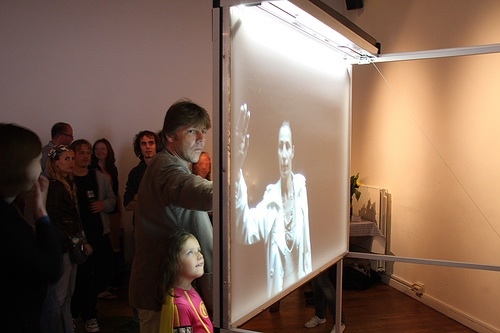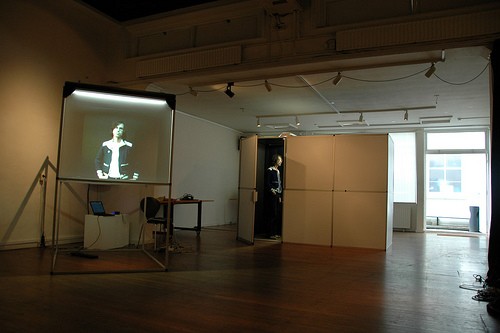Frontera v.2 is an interactive installation composed by two different elements: the interactive portrait (shown in the playback booth) and the video booth.
Interactive (or relational) portrait:
Frontera V.2/portrait works mainly with real time video manipulation in relation with the user's actions. In it the user can interact with a set of different video recorded real life characters that react to his gestures by imitating them. The projected characters imitate specially one gesture: when the users lay their hand over the glass screen where the work is back projected, the person in the video puts his or her hand in the same position, as if touching the user, but while doing so, the character doesn’t sit still, it blinks and breaths, and if the user moves his hand over the screen, now acting as a glass window, the character follows in a mirror like movement. Touch is desirable but not necessary, even the proximity of the user’s hand will make the character react.
Internationally understood and widely seen in movies and television, this gesture speaks both about the need for communication and about the impossibility of communicating. It makes possible an encounter among a real and a virtual character or, more precisely, a character who is physically present and other who is only represented by his apparently live spectral clone.
The videobooth
The video booth is a small room similar in every main aspect to a photo booth (also called photomaton), just like the ones used in public spaces for people to take their own ID format photo portraits. It has an area where the model stands, and a glass window protecting a camera. However, the video booth serves to the purpose of allowing the users to create interactive selfportraits of the kind described in the previous lines, and which are shown in the playback (portrait) component of Frontera.
Using the same kind of technology as the playback booth, the video booth records short video sequences instead of taking pictures. It also records data about the position of the model’s body when a certain take was shot. This information is gathered through a game-like interaction of the model with a graphic interface that guides him though the procedure. After the process that lasts approximately 3 minutes is completed, the user’s mirror image becomes dissociated from him and appears on the playback booth for him or others to interact.
Some ideas about Frontera
Although playful and engaging for the user that can try a countless combination of routes by sliding his hand through the screen, and always getting a response; for a passive observer of the whole choreography, the repetitive gestures also serve as a commentary about interactivity and it’s limitations: there comes a time when one wouldn’t know if it’s the user who acts and the portrayed character who reacts, or if the system ends up implicitly dictating the pace, and direction of the action.
Portrait or mirror?
The first version of Frontera, only consisted in the playback booth. To me it was clearly a rather new kind of time based relational portrait. The characters were recorded wearing their regular cloths, the lighting and framing was carefully controlled, and the long poses reminded of that required for traditional portraits to be made. The expressions in the model's face were clearly visible and affected the final outcome of the work. However, the new version of Frontera includes a videobooth, this is, a tool for the creation of relational portraits. This tool is open to the public to use as they prefer. I had to give up detailed control of the take due to the automatization of the process. New aspects of the work came to play, and the portraits became self portraits or mirror images. The users could interact with their own representations creating strange scenes where the mirror, a private artifact, becomes public, and digitally mediated. The fearless auto exposure of the users to the device, and the taste for publicizing the own image make me think of a generation shaped with the usage of digital imaging, and social networking tools, and whose members have developed a very particular relation to the multiple digital mirrors they look upon.
Tech aspects
An OpenSource application was developed for Frontera v.2. The Frontera team is planning a workshop at the beginning of September on this subject so that other people can create with such software, specially with the motion tracking part. Stay tunned for info in such workshops. For now, you can find the software and related info at: sourceforge.net/projects/frontera
Team
Art Direction/concept:Lilia Perez Romero; programming engineers: Robin Gareus, Arjan Scherpenisse; videobooth structure: Eelco Wagenaar
See for yourself
Frontera v.2 is on display in the Netherlands Institute for Media Arts (also known as Montevideo.nl) until the 26th of july 2008. Why not see Frontera for yourself? If you do stop by, you can also visit 5 days off's Crosswire - in search of the synesthetic effect. But hurry, it's the last week for both shows!


